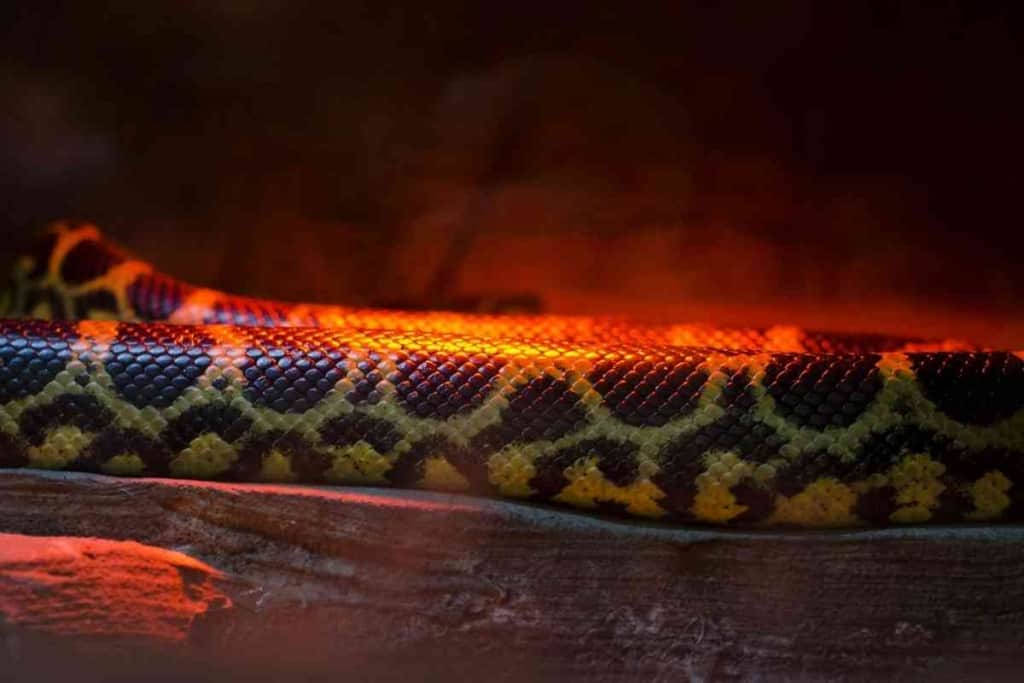Can Snakes See Red Light? A Quick Answer!
Snakes have some amazing abilities, including the ability to see in the dark and to sense vibrations. But can snakes see red light? There’s a lot of debate over whether or not snakes can see red light. Some people say they can, while others claim they can’t. Even scientists argue whether snakes can see red light as some researchers believe that snakes can only see shades of grey and brown because snakes have limited color perception.

Can Snakes See Red Light?
Regarding color vision, snakes are not as limited as one might think. Many snakes can see a wide range of colors, including red. Since red light has the longest wavelength of any visible color. This means that it is slightly less visible to snakes than other colors, and red appears dim and muted to them.
In addition, it is believed that snakes may be able to see ultraviolet light, which could help them to find food and avoid predators. While more research is needed to confirm these findings, it is clear that snakes have a unique way of perceiving the world around them.
There is a lot of false information on the internet, and one question that seems to come up a lot is whether or not snakes can see red light. This expert review will explore the answer to that question and debunk some of the commonly associated myths.
Are Snakes Okay With Red Light?
Snakes are often nocturnal animals, which means they are most active at night. For this reason, many snake owners use red light bulbs in their tanks or cages
But is red light okay for snakes? The answer depends on the type of snake and its natural habitat. Red light is generally safe for snakes from areas with little natural light, such as rainforests.
However, snakes from deserts or other bright habitats may be worse off under red light, as it can disrupt their natural day/night cycle. In addition, to be on the safer side, it is important to consult a veterinarian before making the switch. Whether or not red light is okay for snakes depends on the individual snake and its needs.
Do Snakes Need Red Light At Night?
Contrary to popular belief, snakes do not need a light to be on at night. They benefit from a day and night cycle, which means they need light during the day and darkness during the night. Snakes are cold-blooded animals, which means they rely on their environment to regulate their body temperature.
During the day, they bask in the sunlight to warm up; at night, they hide in the shadows to cool down. If a snake is kept in an enclosure with a constant light source, it can disrupt its day and night cycle and lead to health problems
So, if you’re looking to create a healthy environment for your snake, make sure to provide them with a day and night cycle.

Do Colored Lights Bother Snakes?
When it comes to snakes, there are a lot of myths and misconceptions. One common belief is that snakes are attracted to colored lights.
However, this is not true. Snakes do not see colors in the same way that humans do. Instead, they see a range of light and dark shades. As a result, they are not bothered by colored lights.
They are more likely to be disturbed by bright lights than by colored lights. So if you’re worried about attracting snakes with your outdoor lighting, you can rest assured that colored lights will not bother them.
Can I Use a Red Light For My Ball Python?
While ball pythons are nocturnal animals, they do not require complete darkness to thrive. Red light is often used to provide a gentle source of heat for these snakes.
Red light bulbs emit very little visible light, so they will not disturb your ball python‘s sleep cycle. Additionally, red light bulbs generate less heat than other bulbs, making them a safe choice for heating your snake’s enclosure.
When selecting a red light bulb for your ball python’s habitat, be sure to choose one that is specifically designed for reptiles.
These bulbs are typically safeguarded against overheating and have a longer lifespan than standard incandescent bulbs. Your ball python can enjoy a long and happy life with proper care.
Does Red Light Hurt Reptiles?
Reptiles are a class of animals that includes turtles, snakes, lizards, and crocodiles. Unlike mammals and birds, reptiles are ectothermic and rely on their environment to regulate their body temperature.
As a result, reptiles are often found basking in the sun to warm themselves up. But what happens when they are exposed to a red light?
Red light does not have the same effect on reptiles as on humans. For us, red light is associated with nighttime and can make us feel tired and relaxed.
However, for reptiles, red light is associated with heat. Many reptiles will bask in red light to warm themselves up. So, if you’re wondering whether it’s safe to use a red light bulb around your reptile friend, the answer is yes! The red light will not hurt them and may even help them to stay warm.
Are Snakes Afraid of Lights?
One of the most common myths about snakes is that they are afraid of lights. However, there is no scientific evidence to support this claim.
Snakes are just as likely to be active during the day at night. While it is true that some snakes are more active at certain times of day, this is largely due to their hunting and feeding habits.
For example, nocturnal snakes may be more likely to hunt at night because their prey is more active during these hours. Similarly, diurnal snakes may more likely bask in the sun during the day to regulate their body temperature. So, while there are some exceptions, there is no general rule that snakes are afraid of lights.
What Colors Do Snakes See?
Snakes are dichromatic, meaning they can see two primary colors, blue and green. While this may seem like a limited range of vision, it is well-suited to the snake’s needs.
Blue and green are the predominant colors in the natural world, and by being able to see these colors, snakes can easily blend in with their surroundings.
In addition, snakes have excellent night vision, which helps them to hunt for prey in low-light conditions. While snakes may not have the same colorful view of the world as humans, their dichromatic vision perfectly suits their way of life.
How Do Snakes See Humans?
Most snakes have poor eyesight but make up for it with their other senses. They have heat-sensing pits on their faces that can detect the body heat of their prey, even in complete darkness.
Snakes use their sense of smell to track down food and avoid predators. Some snakes, like pythons and boas, also have tongue flicking, which helps them taste the air and locate prey.
When a snake is ready to strike, it will open its mouth wide and strike with lightning speed. However, the most important sense for a snake is its sense of touch. A snake’s entire body is covered in sensory receptors that help it detect vibrations in the ground. This allows them to sense the approach of predators or potential prey from a great distance.
